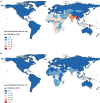Global trends in the incidence and mortality of asthma from 1990 to 2019: An age-period-cohort analysis using the global burden of disease study 2019
- PMID: 36483262
- PMCID: PMC9723391
- DOI: 10.3389/fpubh.2022.1036674
Global trends in the incidence and mortality of asthma from 1990 to 2019: An age-period-cohort analysis using the global burden of disease study 2019
Abstract
Background: Asthma is a major global health challenge. The global strategic management and prevention of asthma report has been published, but health system planning for asthma requires a careful assessment of asthma epidemiology. This study described the incidence and mortality of global asthma from 1990 to 2019.
Methods: Based on data from the global burden of disease study (GBD) 2019, we present spatial and temporal trends in asthma incidence and mortality for the world and its 204 countries and territories from 1990 to 2019. Meanwhile, age-period-cohort analysis was used to explore factors influencing asthma incidence and mortality.
Results: From 1990 to 2019, the incidence of asthma decreased from 601.20 per 1,00,000 to 477.92 per 1,00,000, and the mortality of asthma decreased from 8.60 per 1,00,000 to 5.96 per 1,00,000. High sociodemographic index (SDI) areas have higher age-standardised asthma incidence and low sociodemographic index areas have higher age-standardised asthma mortality. The age-period-cohort analysis results showed that the relative risk (RR) of incidence was high in children and the RR of mortality was high in elderly individuals. The RR of both asthma incidence and mortality showed a decreasing trend over time. The RR of asthma incidence in the recent birth cohort was higher than that in the previous birth cohort. The RR of asthma mortality continued to decline with the change in the birth cohort.
Conclusions: Global asthma incidence and mortality decreased from 1990 to 2019. The decline in asthma incidence was mainly attributed to age effects and period effects, and the decline in asthma mortality was mainly attributed to period effects and cohort effects. Focusing on the risk of incidence in children and the risk of mortality in the elderly, promoting healthy lifestyles and controlling environmental risk factors can help to better control asthma.
Keywords: age-period-cohort analysis; asthma; global burden of disease; incidence; mortality.
Copyright © 2022 Cao, Chen, Chen, Zou, Liu, Wu and Hu.
Conflict of interest statement
The authors declare that the research was conducted in the absence of any commercial or financial relationships that could be construed as a potential conflict of interest.
Figures






References
Publication types
MeSH terms
LinkOut - more resources
Full Text Sources

